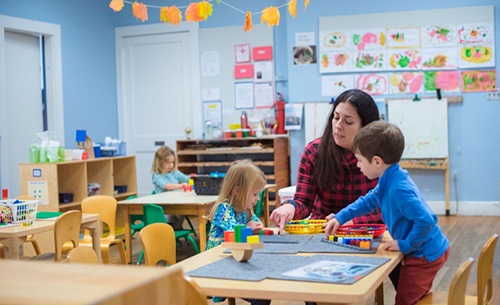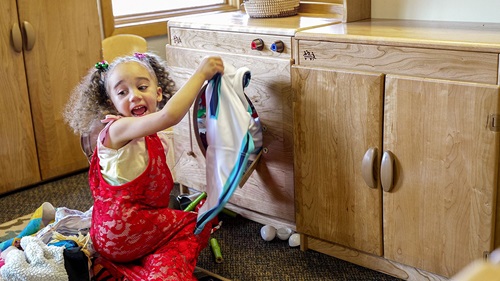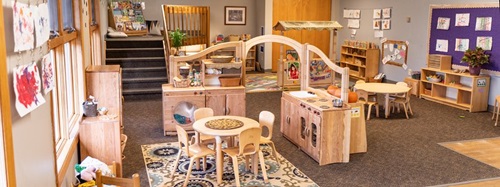Creating a Boy-Friendly Learning Environment:
Supporting the growth and development of young boys
| August 2019For young boys, the early childhood experience is not always a positive, empowering one. Many are struggling because of a mismatch between how most young boys develop, grow, and learn, and the kinds of expectations, outcomes, activities, and discipline approaches typically used in programs during the early years. Francis Wardle’s book Oh Boy! offers positive solutions—from expectations, the environment, instructional approaches, and discipline methods—to policies regarding school readiness and special education.
The following is an excerpt from Chapter 7 which examines the different ways the classroom environment can be arranged to maximize young boy’s development and learning in a secure, nurturing setting. Although these suggestions are specific for the care and education of young boys, many also apply well to the needs of young girls.
Children learn by interacting with the environment: with people (adults and peers) and with things (materials and equipment). They stack blocks; create constructions on the workbench; and dress up as a firefighter with boots, a heavy coat, and hard hat carefully selected from the dress up area. The manner in which the indoor environment is arranged can enhance the way materials are used. Arranging paint, water, brushes, and paper so that they are easily accessible to students facilitates child-directed learning.
The way the classroom environment is arranged can also increase the quality of human interactions. For example, a block area with enough room for several children to actively play together will increase cooperative learning; a cozy reading center with a rocking chair can encourage adults to read to children.
While the design of the indoor environment is greatly influenced by a program’s or school’s curriculum, age of the children served, and length of the school day, a boy-friendly indoor environment should be safe, healthy, and support the following:
- Whole-child learning. Children are whole-child learners—they learn through their senses, emotions, language, and cognition all at the same time. Good environments encourage this kind of development and learning across all domains.
- Multisensory learning. All five senses should be used throughout the day in different combinations. Traditional environments tend to focus on learning through the use of sound—speaking and listening; boys thrive with input for all of their senses when learning.
- Opportunities to control learning.Young children need a sense of control in their learning. This can be achieved through collecting, creating, moving, building, designing, transporting, and constructing.
- A variety of challenges, both in complexity and level of difficulty. The environment needs to continually match the child’s growth, development, and learning as the child becomes more experienced, sophisticated, and learns more.
- Choice. Children become empowered when they make choices; they gain a sense of control over their learning when meaningful choices are provided.
- Peer interactions.The classroom environment needs to provide many opportunities for peer interactions: playing with the blocks together, working on collecting materials, engaging in science experiments as a small group.
- Opportunities for respectful child-adult interactions.Much of learning occurs though deep, meaningful relationships with adults.
- Separation from adults. A child needs to be allowed to make mistakes, stumble, delight in freedom, and create his own social rules and his own rules of order. He needs some time every day to feel like his actions are not being observed and judged.
- Soft and hard surfaces. In general, all indoor environments need to include soft and hard surfaces, and those in-between. Soft surfaces are surfaces that respond to the child’s body contours, and are supportive and relaxing for the child. Hard surfaces require the body to respond to them, and are tiring to the child. However, hard surfaces are ideal for certain activities and learning such as games using balls and skip ropes; these surfaces are also easy to clean (under paint easels and the tables where children eat). In-between surfaces are areas that are carpeted that provide both a stable surface for materials, but are less abrasive to the body than hard surfaces.
- Lots of opportunities. Opportunities for large and small muscle development and eye-hand coordination; opportunities to explore, experiment, and problem solve; and opportunities to be creative and engage in a variety of art activities.
- Lighting. A range of different lighting including natural lighting and uneven pools of light, at least for a part of each day.
- Outdoor access. Easy access to the outdoors throughout the day.
The indoor classroom environment should also have the following in order to encourage optimum learning and development for young boys:
Supply Plenty of Diverse Equipment and Materials
For young children, playing with and manipulating materials and equipment is one of the main ways they directly experience the environment of the early childhood program or school. Children are attracted to materials they find unusual, eye catching, and novel by their color, shape, texture, smell, taste, function, and sound. Equipment and materials for young children serve a variety of functions. In manipulating materials and using equipment, young learners develop a range of fundamental knowledge about the world and how it functions. For example, they learn that when stacking blocks, the blocks will fall if not carefully arranged; that round objects roll; and that the saw must be used in a very specific manner for it to cut a piece of wood. They learn to create, experiment, construct, order, control, and transform. They not only learn scientific and mathematical constructs and principles, but they also develop a sense of control, purpose, and mastery. And well designed and selected materials and equipment encourage a range of social interactions and cooperative learning.
Some specific ideas for selecting classroom materials and equipment include the following:
- Initial and prolonged interests. A classroom environment must provide for two kinds of interests—initial interest (i.e., attractive because of colors, novelty, and potential use) and prolonged interest (i.e., that which holds the child’s interest day after day), especially in programs where children spend many hours every day.
- Open-ended and closed-ended materials. Toys and other materials can be categorized as open- or closed-ended. Open-ended materials such as sand or water are those that children can engage with in many ways. Closed-ended or high-structured play materials can only be used in very limited ways. Jigsaw puzzles have one correct solution; realistic replicas of farm animals can only be used in one way. Closed-ended materials can build a sense of mastery in children such as hammering a nail, or using an art or writing instrument in a specific way. But they require a high level of adult involvement, at least initially, and children can become bored and frustrated with these materials. There are also materials that fit between these two extremes, such as Legos and unit blocks. Individually, they have limited use due to their shape, but together, through the extensive use of constructive play, they provide for a wide variety of choices. Programs should provide open- and closed-ended materials, and those that lie in-between. However, open-ended materials and equipment give children a sense of control, and are well suited for young boys. These materials also enable children to engage with the material at their current level of development with interaction becoming more sophisticated as the child’s development increases. This continues to maintain the important goodness-of-fit between the materials and equipment, and the child’s development and experience.
- Concrete manipulatives. Young children learn a great deal about their world through direct manipulation of the physical environment, and a good early childhood environment provides for a wealth ofconcrete manipulatives.Young boys love to play with unit blocks and other math manipulatives. However, many educators—and some parents—see this simply as “play” and not as an essential tool in learning math, engineering, vocabulary, architecture, and other basic concepts. And teachers often do not scaffold this play to help children learn evermore complex, abstract, and symbolic concepts as they interact with blocks. Concrete manipulatives include:
- wooden blocks of different shapes and sizes;
- wooden beads of different colors, shapes, and sizes;
- found objects such as buttons and tokens of different shapes, sizes, textures, and novelty;
- natural materials such as sticks, pieces of wood, leaves, and stones; and
- dried seeds of different shapes, sizes, textures, and colors.
- Relevant materials that encourage dramatic play. There are two kinds of materials that encourage dramatic play: real-life props such as hats, shoes, coats, and fire hats and hoses; and miniature items like farm animals and zoo animals, miniature people, and dolls. In both cases, the materials enhance play and learning by acting as a prop or stimulus. For young boys, they provide important clues to encourage all sorts of dramatic play including opportunities to extend and engage in ideas they bring to the program or school from their own family, community, and culture.
Organize the Space into Interest Areas/Centers
Typical early childhood classroom centers include a sand and water table, blocks, dramatic play, art, games and puzzles, books and writing, woodworking, music and movement, science, and computer. Learning centers reflect the values and philosophy underlying the learning that is expected to take place in that space. In each learning center there is a collection of carefully selected and arranged materials that encourage individual and small group learning and interactions that reflect the program’s philosophy and curriculum.
For programs that meet the needs of young boys, the centers should match the various ways young boys learn, behave, and interact. Here are some ideas on how to create learning centers that match the needs of boys.
|
Book and writing area. Make sure that there are books that young boys find interesting: cars, trucks, constructions, animals, insects, sports, monsters, yucky things and gross events, superheroes, things that make strange and freighting noises. Some of these books should also be well illustrated with photographs and drawings. A computer should be included in this center as it can be used to extend writing activities, conduct research, and further explore topics. Block area. Include cars and trucks, miniature wild and domestic animals, Legos, signs, and other building materials, and pictures—including architectural drawings—of construction sites, houses, bridges, towers, highways, and natural elements. Dramatic area. Include props for activities that many men stereotypically do at home: barbeques, workbench, old car tires, briefcase, farm props, gas station props, carpentry, mechanical, and gardening tools. Include hardhats, firefighter’s coats, fire hoses, police hats and badges, football helmets and baseball hats, and truck driver’s tools. Science area. Include old typewriters, household appliances, bones, skulls, snake skins, stones, lots of different growing plants, decaying items, and things children bring in from the playground and field trips (obviously health and safety must be maintained). This is an ideal space to display items collected from the Project Approach site. Games, puzzles, and math manipulatives area. Games and puzzles should reflect themes that young boys are particularly interested in. Woodworking area. Include workbench, tools, wood, pieces of plywood and masonite, dowels of differing sizes, and other materials and attachments. Yarn, hinges, brackets, and decorative hardware can be added. This can be in the classroom, in an area on the playground, or in a transition area between the classroom and playground. Art area. In the art center, young boys can mess around with a variety of art material, experiment, try out new ideas, and create. In this area, it is OK to make a mess! Often art activities focus on process rather than product, which takes the pressure off young boys to always compare their work with other students. Because there are so many different art materials, instruments, and surfaces, this is a center that is easy to continually change and add to. |
Get your copy of the book:
Take 20% OFF on your order by using coupon code OHBOY20
Copyright © Exchange Press. Reprinted with permission











